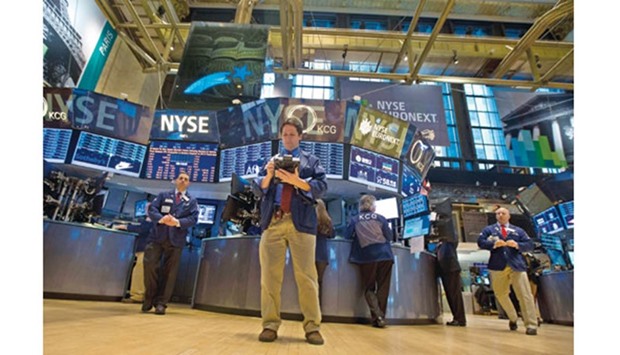As 2015 draws to a close this week, the fortunes of the last few trading days of the year may be dictated by the direction of the financial sector.
The financials have risen more than 6% this quarter, with investors expecting the sector to be one of the main beneficiaries of the first interest rate hike by the US Federal Reserve in nearly a decade last week.
However, the potential exposure of banks to the energy-dominated US high-yield corporate bond markets has unnerved investors, and caused financial and energy shares to stall during the two trading sessions that followed the hike. Stocks in both those sectors have been closely correlated in recent weeks.
“That trade, the oil-financials, it is going to be with us for quite some time,” said Peter Kenny, equity market strategist at Kenny & Co, in Denver. The benchmark S&P 500 index has rallied nearly 3% this week, buoyed by a jump of nearly 5% in the energy sector as oil prices bounced off multi-year lows. Financial stocks, meanwhile, have surged more than 3% this week.
In recent weeks, energy stocks have been tightly correlated to the price of crude at 0.95, which means they have moved in sync with each other, and financials have not been far behind. The 20-day correlation between the financial sector and US crude is 0.75.
Should oil prices fail to stabilize and energy shares continue to fall, that could be reflected in the financials.
“The influx of money and capital into the financials over the last six months in anticipation of this move by the Fed was justified, but boy, this oil trade has turned that upside down,” Kenny said.
The slump in oil prices has resulted in a drop of more than 20% in the energy sector this year, but while signs of stabilization in the commodity has helped the sector rally, it has also reduced its influence among the broader index.
According to Standard & Poor’s, as of November 30, the energy sector held a 7.1% weighting in the benchmark index. In contrast, financials hold a 16.6% weighting, second among the 10 major sectors and making them more influential in dictating the direction of the S&P 500.
Financials have a forward price-to-earnings ratio of 13.7, according to Thomson Reuters data, making them relatively cheap compared to the 16.5 for the broad S&P 500.
Meanwhile, as major US banks have raised the rates they charge borrowers in the wake of the Fed hike, that could bump up earnings for the sector.
Even if financials manage to decouple from oil, some market participants are not expecting any outsized benefits for the sector from the change in Fed policy, which is expected to be a gradual tightening of interest rates. “Interest rates are going to stay here and this trade that led people to believe the banks were going to be substantially helped is just not going to happen,” said Stephen Massocca, Chief Investment Officer, Wedbush Equity Management in San Francisco.
“They are probably fairly valued here and they are very disinteresting.”
With a shorter trading week ahead as well due to a holiday for New Year’s, the economic calendar is light and trading volume is expected to be muted, which could result in exaggerated moves in equities.
“Due to the holiday week, attendance will be light,” said Andre Bakhos, managing director at Janlyn Capital in Bernardsville, New Jersey.
“But the ability to move things around is easier at times like this, so while we normally think that nothing is going to happen, it is easier to make things happen.”

Traders work on the floor of the New York Stock Exchange. As 2015 draws to a close this week, the fortunes of the last few trading days of the year may be dictated by the direction of the financial sector.


